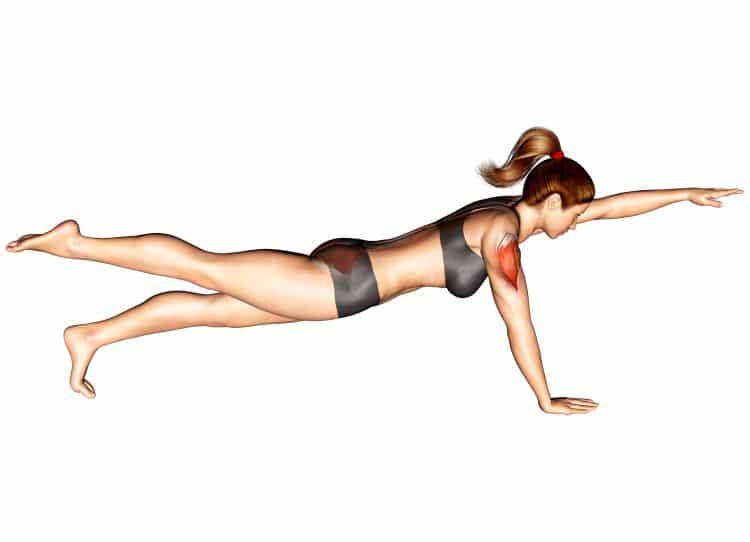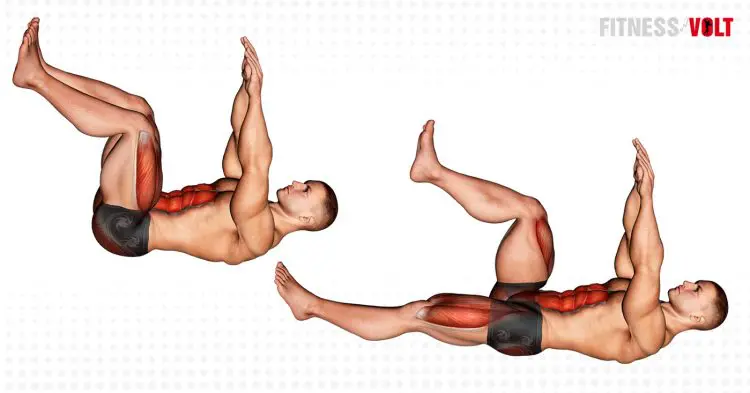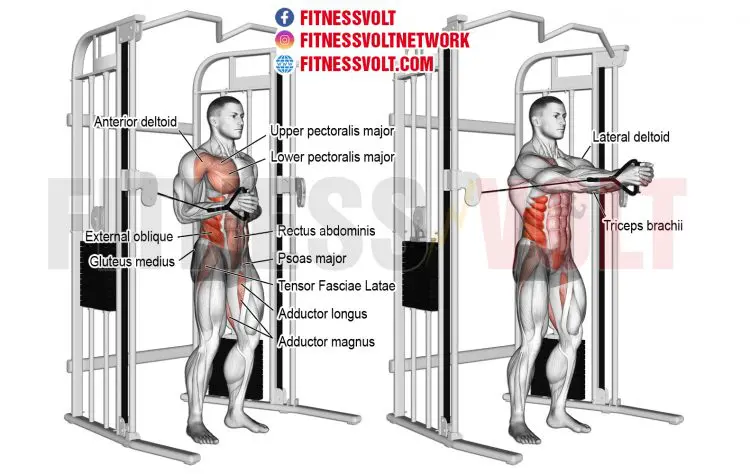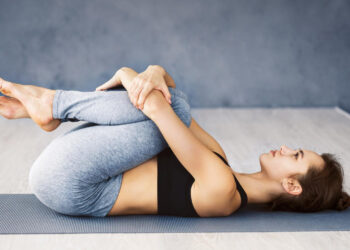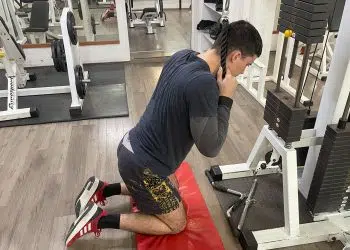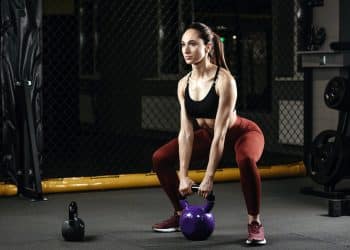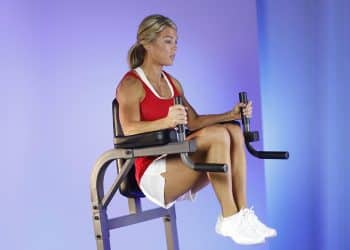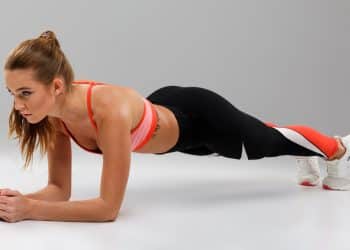When it comes to strength training, most people spend most of their workouts focusing on the muscles they can see. They’ll do bench presses for the pecs, curls for the biceps, and squats for the legs. This makes a lot of sense because a large proportion of exercisers are working out to look better.
However, beneath that superficial layer of muscles is another layer that’s every bit as important. The muscles you can’t see also affect how you look, perform, and feel.
In this article, I’ll discuss one of the most important deep muscles, the transverse abdominis, its functions, and how best to train it. I’ll also share the most effective transverse abdominal workout I use with my personal training clients so you can get a tight and shredded midsection.
Recent Updates: On June 14, 2024, Fitness Volt’s Senior Editor, Vidur Saini (American Council on Exercise-CPT), updated the article and added actionable expert tips throughout the piece to improve the reader experience.
Level Up Your Fitness: Join our 💪 strong community in Fitness Volt Newsletter. Get daily inspiration, expert-backed workouts, nutrition tips, the latest in strength sports, and the support you need to reach your goals. Subscribe for free!
10 Best Transverse Abdominis Exercises
A stronger transverse abdominis (TVA) means increased intra-abdominal pressure (IAP) and a more stable lumbar spine. This could reduce the risk of back injury and increase workout and overall physical performance.
For example, if your TVA bulges outward during squats and you lose IAP, your lower back may start to round, increasing the stress on your intervertebral disks and spinous ligaments. Also, your hips may rise while the weight remains stationary, reducing exercise performance.
Here are ten of the best exercises for increasing TVA strength.
- Plank
- Bird Dog
- Dead Bug
- Stir The Pot
- Pallof Press
- Single-Arm Farmer’s Walk
- Single-Arm Waiter’s Walk
- Rollouts
- Pilates 100
- Push-Up To Side Plank
1. Plank
| Sets & Reps | Equipment Needed | Target Muscles |
| 3 x 30-60 seconds | Bodyweight | Rectus abdominis, transverse abdominis, obliques, erector spinae |

Planks are a good place to start training your TVA. This classic abs exercise involves a strong bracing element, which means your TVA is especially active. Don’t plank passively, and try to see how long you can keep your hips up. Instead, brace your abs as hard as possible, tensing your entire body too.
This is called a hardstyle plank and is much more effective than the lower-intensity version. With hardstyle planks, you should not be able to continue much past 20-30 seconds. If you can, you are not bracing hard enough.
Pro Tip: Actively pull your elbows towards your toes (without actually moving them) to further engage your core and create a more solid base.
| Difficulty | Progression | Regression |
| Beginner | Increase hold time | Forearm plank or knee plank |
Read more about hardstyle planks, also known as RKC planks, in this detailed guide.
2. Bird dog
| Sets & Reps | Equipment Needed | Target Muscles |
| 3 x 8-12 per side | Bodyweight | Transverse abdominis, erector spinae, gluteus maximus, core stabilizers |
Bird dogs don’t look especially hard, but they’re a good exercise for identifying and using your TVA while you move your arms and legs. After all, you need to get used to bracing during all the exercises in your workouts, and not only while stationary, like when you do planks.
“Squeeze your glute before lifting your leg,” says Saini. This pre-activation helps to stabilize your pelvis and ensure proper core engagement during the lift.
How to do it:
- Kneel on all fours with your hips directly over your knees and your shoulders above your hands. Lengthen your neck and look straight down at the floor. Brace your abs.
- Extend your right arm and your left leg, keeping the rest of your body stationary.
- Lower your arm and leg and repeat. Bring your elbow and knee together beneath you if you wish.
- Rest a moment and then swap sides.
- Once mastered, you can do this exercise with your legs straight and knees off the floor, which is called a high bird dog.
Pro Tip: Focus on maintaining a long, neutral spine while creating tension throughout your entire body.
| Difficulty | Progression | Regression |
| Beginner | Add resistance bands | Keep one limb stable |
3. Dead bug
| Sets & Reps | Equipment Needed | Target Muscles |
| 3 x 8-12 per side | Bodyweight | Rectus abdominis, transverse abdominis, obliques |
The dead bug is a more demanding version of the kneeling bird dog. Lying on your back means you’ll have to stabilize your core while lifting and lowering your legs and using your rectus abdominis.
Saini recommends exhaling sharply as you extend your arm and leg, as it helps activate your deep core muscles (transverse abdominis) and stabilize your spine.
How to do it:
- Lie on your back with your knees bent. Your upper legs should be vertical, and your lower legs parallel to the floor. Your knees and hips should be at a 90-degree angle.
- Raise your arms, so they are perpendicular to the floor. Flatten your lower back.
- Brace your abs and lower your right arm and left leg down toward the floor. Do not arch your lower back.
- Return to the starting position and repeat with the opposite leg.
- Alternate sides for the duration of your set.
Pro Tip: The slower you go, the harder your core works. Control the movement and make every rep count.
| Difficulty | Progression | Regression |
| Intermediate | Add weight | Bird dog |
4. Stir the pot
| Sets & Reps | Equipment Needed | Target Muscles |
| 3 x 10-15 circles per direction | Stability ball, optional weights | Rectus abdominis, transverse abdominis, obliques, shoulders (serratus anterior) |
If you can plank like a boss, it’s time to step things up a bit and add some extra movement and instability. With this exercise, you plank as usual but then move your arms, which means you’ll have to brace extra hard to prevent unwanted spine extension.
Avoid excessive arching or rounding of your lower back by engaging your core throughout the movement, says Saini. Prioritize initiating the movement from your obliques.
How to do it:
- Place your forearms on a stability ball, and then walk your feet back and into a plank position. Brace your abs.
- When you are ready, rotate your arms in small clockwise and counterclockwise circles. Increase the size of the circles as you get stronger.
- You can also roll the ball forward and backward for variety.
Pro Tip: Prioritize quality of movement over quantity. Smaller, controlled circles can be far more effective than large, sloppy ones.
| Difficulty | Progression | Regression |
| Advanced | Increase range of motion | Dead bug |
5. Pallof press
| Sets & Reps | Equipment Needed | Target Muscles |
| 3 x 8-12 per side | Resistance band | Obliques, transverse abdominis, core |
Like many TVA exercises, Paloff presses are an anti-movement exercise, which means you’ll need to brace to stop your spine from flexing, extending, or rotating.
Keep your hips squared forward and resist the urge to twist them as you press the band away, cues Saini. This will force your core to work harder to stabilize your spine. There are several Pallof press variations, including:
- Half-kneeling Pallof press
- Split stance Pallof press
- Cable Pallof press
- Overhead Pallof press
- Resistance band Pallof press
Pro Tip: As you get stronger, walk away from the anchor point for greater core engagement.
| Difficulty | Progression | Regression |
| Beginner | Use cable machine | Half-kneeling Pallof press |
Read more about Pallof presses here.
6. Single-arm farmer’s walk
| Sets & Reps | Equipment Needed | Target Muscles |
| 3 x 20-30 yards per side | Kettlebell or dumbbell | Transverse abdominis, forearm flexors, upper traps, core, hip stabilizers |
Single-arm farmer’s walks might look more like a forearm exercise than something that’ll strengthen the TVA, but they’re a very functional deep abdominal exercise. When doing single-arm farmer’s walks, you’ll have to brace extra hard to avoid leaning sideways.
Lift as heavy as possible without compromising form to challenge your deep core muscles, says Saini.
Level Up Your Fitness: Join our 💪 strong community in Fitness Volt Newsletter. Get daily inspiration, expert-backed workouts, nutrition tips, the latest in strength sports, and the support you need to reach your goals. Subscribe for free!
How to do it:
- Pick up a heavy dumbbell or kettlebell and hold it in one hand, with your arm by your sides. Brace your abs and make sure you keep your torso upright — no leaning toward or away from the weight.
- Walk around your training area for as long as you can. Put the weight down as you feel your grip starting to fail.
- Swap hands and repeat.
Pro Tip: Consciously pull your shoulder blade down and back before lifting the weight. This creates stability and helps prevent shoulder impingement.
| Difficulty | Progression | Regression |
| Beginner | Use a barbell | Bilateral farmer’s walk |
Read more about farmer’s walks in this detailed guide.
7. Single-arm waiter’s walk
| Sets & Reps | Equipment Needed | Target Muscles |
| 3 x 20-30 yards per side | Kettlebell or dumbbell | Transverse abdominis, shoulders, upper traps, core, hip stabilizers |
Bored of farmer’s walks? Try waiter’s walks instead! With this exercise, you hold the weight overhead, which means the load is much less stable. As a result, you’ll need to work even harder to keep your torso upright.
Saini recommends keeping your bicep close to your ear to activate your rotator cuff muscles and help stabilize your shoulder joint, reducing the risk of injury.
How to do it:
- Clean and press a dumbbell or kettlebell overhead. Pull your shoulder down and back and brace your abs.
- Keeping your arm vertical and locked, walk around your training area for as long as you can.
- Lower the weight, swap sides, and repeat.
- Try supersetting waiter’s walk with farmer’s walk for a very tough and challenging TVA workout.
- Make the waiter’s walk harder by walking around and over obstacles, increasing the stability demands of this exercise.
Pro Tip: Shoulder stability is key to this exercise. Engage your lats and imagine you’re trying to crush a walnut between your shoulder blades.
| Difficulty | Progression | Regression |
| Advanced | Increase weight/distance | Farmer’s walk |
8. Rollouts
| Sets & Reps | Equipment Needed | Target Muscles |
| 3 x 8-12 | Ab wheel or barbell | Rectus abdominis, transverse abdominis, obliques, latissimus dorsi |
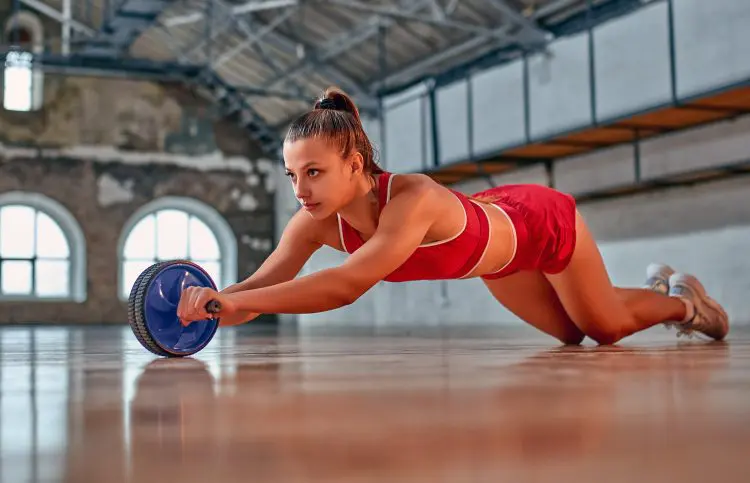
Rollouts are a sort of moving plank. Most people do this exercise because it’s a great abs strengthener and an effective TVA exercise. Brace hard to stop your lumbar spine from extending as you push your roller away from you.
Resist the urge to collapse as you roll out, Saini says. Instead, slowly and deliberately lower yourself to the ground, engaging your core throughout the movement.
You can do rollouts in several ways, including:
- Kneeling
- Standing
- Abs roller/wheel
- Barbell
- Suspension trainer
- Stability ball
- Landmine
Pro Tip: Pause in the bottom position for a deep ab stretch.
| Difficulty | Progression | Regression |
| Advanced | Standing rollouts | Planks |
Learn more about this powerful TVA exercise here.
9. Pilates 100
| Sets & Reps | Equipment Needed | Target Muscles |
| 1 x 100 pumps | Mat (optional) | Rectus abdominis, transverse abdominis |
Pilates training involves a lot of TVA-specific exercises. The Pilates 100 is an effective and convenient move because you don’t need any equipment to do it.
Saini recommends coordinating your breath with the movements of your arms. Focusing on drawing your navel towards your spine with each exhale.
How to do it:
- Lie on your back with your legs straight and arms by your sides. Brace your abs and lift your legs so they’re about 45-degrees to the floor. Lift your arms a few inches off the floor. Flatten your lower back.
- Lower and raise your arms 100 times while continuing to brace the entire time.
- Make this exercise easier by bending your knees.
Pro Tip: Deep, controlled breathing will enhance your core engagement and make the exercise more challenging
| Difficulty | Progression | Regression |
| Advanced | L-sits | Pallof press |
10. Push-up to side plank
| Sets & Reps | Equipment Needed | Target Muscles |
| 3 x 8-12 per side | Bodyweight | Transverse abdominis, chest (pectoralis major), shoulders (deltoids), triceps, obliques |
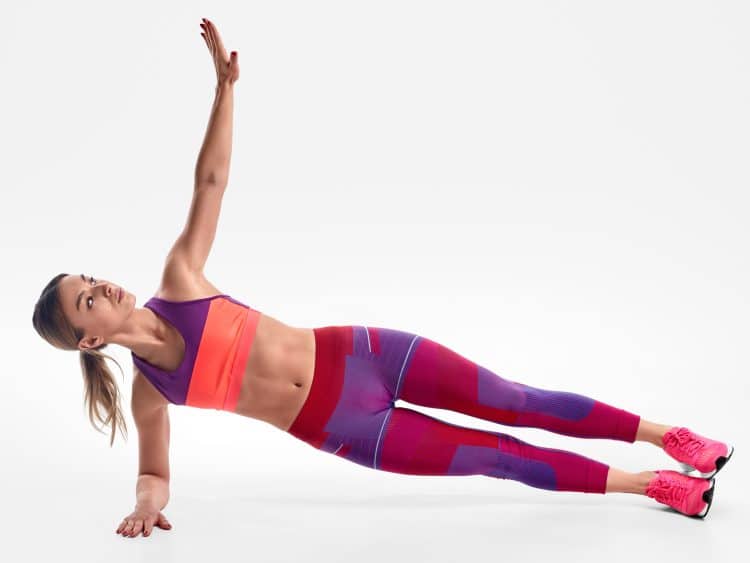
Push-up to side plank exercise hits your TVA from multiple angles. It combines moving your upper body with bracing your core, making it both functional and time-efficient.
Saini recommends thinking of this exercise as a dynamic plank. As you transition between positions, focus on maintaining a strong core and avoiding any twisting or sagging in your hips.
How to do it:
- Place your hands on the floor about shoulder-width apart and walk your feet back until your body is straight. Brace your abs.
- Bend your arms and lower your chest to within an inch of the floor.
- Push yourself back up, shift your weight onto one hand, and then turn your shoulders until you are resting on one outstretched arm. Extend your other arm up toward the ceiling to form a T-shape. Pause here for 2-3 seconds.
- Return to the push-up position, do another rep, and then repeat on the opposite side.
- Continue alternating sides for the duration of your set.
Pro Tip: Push your shoulder blade away from your spine as you reach your arm overhead. This activates your serratus anterior muscle, creating more stability and improving the overall effectiveness of the exercise.
| Difficulty | Progression | Regression |
| Intermediate | Ab rollout | Knee push-up to side plank |
Best Transverse Abdominis Workout
Perform the following workout twice weekly for the best results:
| Exercise | Sets | Reps/Time | Rest |
| Plank | 3 | 45 seconds | 30 seconds |
| Bird Dog | 3 | 10 per side | 30 seconds |
| Dead Bug with Ball Squeeze | 3 | 12 per side | 30 seconds |
| Stir the Pot (knees bent) | 3 | 15 circles (each direction) | 30 seconds |
| Pallof Press | 3 | 12 per side | 30 seconds |
Transverse Abdominis
When asked, most people can identify their main midsection muscles. After all, a lot of exercisers are working out specifically to achieve a lean, toned six-pack. Even non-gym-goers are familiar with the term abs and may even know that it’s short for rectus abdominis.
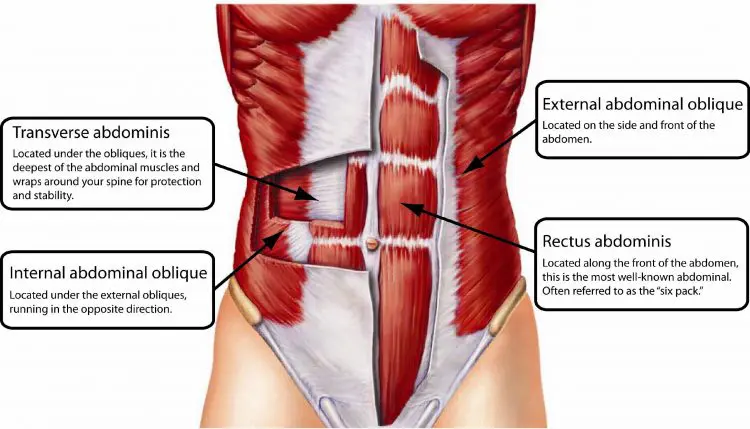
However, below the abs is another set of muscles which are often referred to as the inner unit. The inner unit comprises three lesser-known but no less important muscles:
- Diaphragm: The main breathing muscle and the top of your inner unit
- Pelvic floor: A figure-eight-shaped muscle that supports your pelvic organs
- Multifidus: A muscle located across your lower back
- Transverse abdominus: A deep abdominal muscle that encircles your abdomen like a belt
Of these four muscles, the transverse abdominis, or TVA for short, is arguably the most important because it’s the easiest to control and train.
The TVA encircles your waist like a broad, muscular weightlifting belt or corset. It’s a thin muscle, but it’s also powerful. To feel your TVA working, sit or stand with your thumbs on your waist and your fingers on your abs.
Exhale forcefully, and you’ll feel tension beneath your fingers, and your muscles will contract inward. That’s your TVA in action, working alongside your rectus abdominis to compress your abdominal contents.
The TVA also plays a critical role in stabilizing your spine and preventing unwanted movement during exercises like squats, deadlifts, and overhead presses.
TVA is involved in almost every exercise you perform, including abs exercises. But there are several exercises you can do to target this muscle more directly, increasing TVA strength.
More Abs Exercises:
- The 10 Most Awesome Upper Abs Exercises
- 15 Best Cable Exercises for Abs
- 10 Barbell Exercises For Abs
- Do Squats Work Your Abs?
- 7 Ways to Do Rollouts When You Don’t Have an Abs Wheel
- Best Abs Exercises to Build Core Strength for CrossFit
- Planking It! Five Minute Plank Workout for Shredded Abs
Wrapping Up
Just because you can’t see your transverse abdominis doesn’t mean it’s not a crucial muscle. It supports your spine when you are doing many of the exercises in your workout and, if it’s weak, it could undermine your performance and affect your progress. It could even increase your risk of back injury.
As well as engaging your core and bracing during your workouts, you may benefit from some more direct TVA training. You don’t have to go all TVA, all the time. But, it’s definitely worth incorporating a couple of TVA exercises into your regular abs workout. The good news is that most of them also work your rectus abdominis and obliques, so you’ll get the best bang for your training buck.
References:
1– PubMed: Role of Intra-Abdominal Pressure in The Unloading and Stabilization of The Human Spine During Static Lifting Tasks https://www.ncbi.nlm.nih.gov/pmc/articles/PMC3233951/
2– PubMed: Effects of A Belt On Intra-Abdominal Pressure During Weightlifting https://pubmed.ncbi.nlm.nih.gov/2709981/
Interested in measuring your progress? Check out our strength standards for Bench Press, Clean and Press, Clean, and more.

